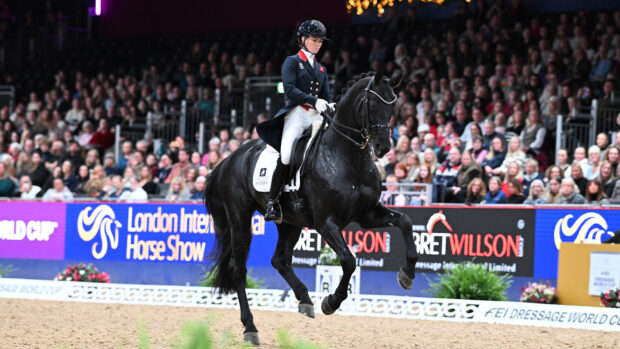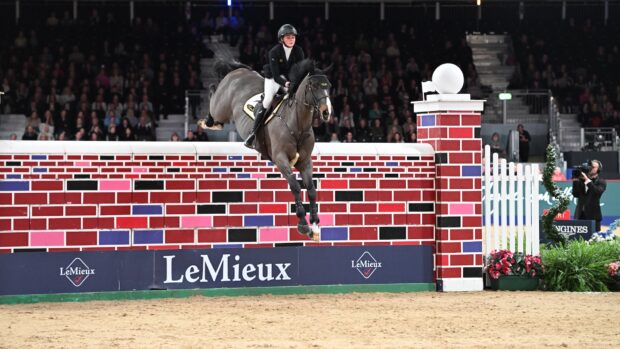Changing the way we talk about equine welfare – and treating horses like horses rather than “like kings” – may not only improve it, but also protect our sport for the future.
This was the conclusion of a study on what was said after welfare campaigners gained access to the racecourse before the 2023 Grand National. The paper, published in Animals, investigated how what was said could affect public acceptance of involvement of horses in sport.
Gemma Pearson, an equine vet, behaviour specialist and racing fan, told H&H the paper “wasn’t an easy one to write”.
The study focused on the commentary from the racing industry; its main message is that although protestors Animal Rising’s aim was to prevent a horse suffering a fatal injury in the race, in the main, pro-racing figures concentrated on the way horses are treated when not racing.
It cites a radio debate two days after the race, in which Animal Rising and representatives of racing featured. But despite the campaigners’ repeating the risks to horses in racing, and public contributors echoing this, “racing’s representatives were once again reluctant to address Animal Rising’s main point”.
Dr Pearson added: “Racing should have dealt with these things. They don’t realise they’re digging a grave for racing with their words. They think they’re selling the sport, but don’t have a good enough understanding of social licence principles.”
She compared the issue to some in general horse sport – experts have reiterated before that most of the public sees no difference between the disciplines – such as if a horse is eliminated for blood.
“The commentator might try to manage it by saying, ‘Horses have such thin skin… a tiny glance of the spur,’ but that’s not right to say,” she said. “Then people ask, ‘Surely they’re not allowed to wear sharp spurs?’ They’d be better to say, ‘Feel sorry for the rider, but that’s a lesson learned; that’s excessive spur use.’ Transparency is very important.”
Dr Pearson said the future of equestrian sport depends on whether the public trusts the industry to safeguard horse welfare.
“If they don’t, they’ll insist it’s regulated, which would probably be by people who don’t understand horse sport and welfare,” she said. “We’ve got to say the right things, and prove it, and then the spotlight comes off.”
She cited the difference between zoos and circuses; the latter has largely lost public acceptance, but the former has kept it by shifting focus to conservation and education.
“Times change and people think they can push back and stop the change, but actually they accelerate it,” she said.
Another example is McDonald’s, which came under fire from campaigners about animal welfare. Instead of trying to quash the protests, the company engaged independent welfare assessors and invested in training, showed they had done so, and “as soon as they did that, no one was interested in what the protestors said”.
“We need to be willing to look at research,” she said. “There was a tendency to say, ‘I’ve been around horses all my life; I know everything.’ People feel threatened, then tend to push away the threat rather than deal with it.”
Dr Pearson added that the public “understands it is impossible to completely eliminate risk in sport” but does want to know the industry cares about and is doing all possible to minimise it.
“The aim of the paper wasn’t to upset people,” she said. “But as a vet who works on racecourses, I want racing to continue. I hope this will help the industry.”
World Horse Welfare CEO Roly Owers told H&H the paper is a “constructive contribution to discussions on how racing – indeed all of horse sport – can evolve the way they communicate to maintain public acceptance”, and that there are two “especially pertinent” points.
“Firstly, when responding to public concerns, these need to be acknowledged directly, including what is being done to address them,” he said. “This will help build trust. Public anxiety about risk of injury and fatality in racing will not be assuaged by assurances that a racehorse has a high quality of life off the track.
“Secondly, beware of the mantra that racehorses are ‘treated like kings’. The public already expects that they receive the highest level of care. And we know that for horses to have a good quality of life, they do not need to be treated like kings – they need to be treated like horses. This means ensuring their mental wellbeing, as well as physical welfare, including plenty of access to turnout and forage, and the ability to socialise with other horses.
“We hope this paper provokes thought and will help develop how the media, horse sport and the racing community communicate about the benefits and challenges within this most visible demonstration of the inspirational horse-human relationship.”
H&H has approached the British Horseracing Authority for comment.
You might also be interested in:

Reduction in number of horses for 2024 Grand National: ‘Welfare is our number one priority’

The horse world must be brave and proactive as many do not support horse sport

*Opinion* Scaremongering clickbait, or a very real threat to the sport we all love?

Subscribe to Horse & Hound magazine today – and enjoy unlimited website access all year round
Horse & Hound magazine, out every Thursday, is packed with all the latest news and reports, as well as interviews, specials, nostalgia, vet and training advice. Find how you can enjoy the magazine delivered to your door every week, plus options to upgrade your subscription to access our online service that brings you breaking news and reports as well as other benefits.




